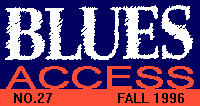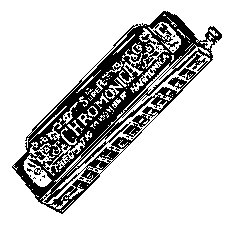

 | ||
| The Doctor is In! |

Morning breaks. As a shaft of light from above signals the dawn of a new day. The slugabed Doc yawns and stretches, rousing himself from a dream of dining on bad pasta and finding to his chagrin that his al dente linguini is, in the cruel light of day, in fact his Cisco Kid lariat and bolo tie decoder combo. Worse, the window that he lamented as being a smidge too tight, as was he, when he attempted to chin himself up and over the sill into a friend's studio apartment, was in point of fact the hatch to the mailbox he now inhabited. The only good news is, in stretching toward the light like a rose through the concrete, his healing hand grasps an envelope containing the plaintive cry of yet another harp player in distress. "Lucky that this decoder is luminescent," he muses as he filches the enclosure from some poor soul's Cheese-of-the-Month-Club Gorgonzola-rama, which made a dandy pillow last night. Munching, he reads. Wish you were here ...
Dear Harpo,
Keep the info coming on the little-known "key instrument" of the blues ... the harp.
Since I picked up the harp on December 19, 1994, I have been focused on the many techniques needed to play the blues. I've been listening for years and wanted to learn. Well now the time is right, and with my band Raging Sun we've been supporting the blues in Southern California and have been privileged to open for Rod Piazza, Coco Montoya, Johnny Winter and others, plus play last year's O.C. Blues Festival. Life's been good.
My quest is to network with the powers that be at a blues label and develop an awareness so we can get a distribution deal. Any suggestions or contacts you might have would be appreciated, We will be ready for the studio this summer: Pacifica in L.A.
Now my key question: What recording advice would you give me so I can get the crunchy Chicago sound from the studio, i.e. mikes, settings, amplifiers, techniques, etc., or is it a case of getting experienced engineers? Any advice will be appreciated.
River Blue
Dear Mr. Blue
I've done a phone survey on your behalf, starting with harp jack-of-all-trades and co-developer (with Magic Dick) of Magic Harps, Boston's Pierre Beauregard. Pierre said that the best way to get leads on labels is to survey some of the nationally touring players for leads. You know, Rod Piazza, Coco Montoya.
As to that sound you want, take as many different pieces of equipment as possible to the studio with you to give yourself as many options as possible. As for amps, use tubes, of course, and check out what kind you have and how old they are. Experiment with different configurations and brands. The smaller the amplifier, the more you can max it out, and you might have to try three or four different amp/mike combos to get the right sound on a cut, and then change the setup completely for the next.
For mikes, Beauregard suggests old Green Bullets, Shure P545 (ala Butterfield), Astatic A 30 or T-5, and the ball-peen hammer of harp mikes, the EV 630. As to settings, just don't blow too hard. Especially with tweed amps, you can overblow into them and give too much signal. Boost the sound volume in your earphones instead; it'll keep you from trying too hard for volume.
Beauregard also offered some nifty recording tricks. Like the "Charlie Christian Approach," using both a hand-held mike for your overblown sound and an acoustic mike to pick up the ambient acoustic harp sound and blend the two together at the board for different coloration. Try miking the amp while it's turned right on up, and use a long cord on your mike, so you can wander around the room at various locales and heights until you hit a sweet spot where it sounds optimum to you. Place a room mike and an amp mike there, and blend the two sounds, as above.
He also offered some advice to optimize your time in the studio. Do your homework and investigate how to talk to engineers. Learn to communicate intelligently about sound frequencies, to know the difference between 2K and 4K. Find a 10 pan EQ and mess around with it, learning and experimenting, before you hit the studio.
Kevin Magowan was brief and to the point: When it comes to recording, Gibson amps beat Fender amps.
Tom Ellis is the old mikes master in Texas. He puts out a weekly newsletter and price list of classic and custom gems. Call him at (214) 328-3225, write him at P.O. Box 140093, Dallas, TX 75214. He picked up a lot of tips from James Harman, a master of the Big Ass Sound. Ellis says Harman records in the old style, using ambient rooms and small amps with 6-inch or 8-inch speakers cranked to the point of being overdriven. The only way to get the volume up sufficiently is to get far enough away from the amp, even if it's in another room, the restroom or even in the building next door (a technique he heard was used once by a player using two Twins cranked up to "9" in the warehouse next door to the studio).
Go for small-tube amps, and the more bottom-heavy
the better. Ellis recommends using old mikes to mike amps, such
as old Shure ribbon mikes, and also suggests experimenting with
mike placement in the room for optimum sound.
He says artists
Gary Primich and Harman both emphasize being as low-tech as possible
to create that old sound,  and cites Mike Ford as an example of
the opposite approach,
that of going from the amp head directly
into the board, yielding a much more polished sound without the
funk that bouncing around the room will add to your pure
signal.
and cites Mike Ford as an example of
the opposite approach,
that of going from the amp head directly
into the board, yielding a much more polished sound without the
funk that bouncing around the room will add to your pure
signal.
Ellis suggested using old Webcor portable record players with oval 6-inch speakers, or old Webcor P.A. systems with 8-inchers, since "small stuff is where you get the sound." He also mentioned the work Gary Onofrio is doing to customize harp amps, using 6's or 8's, fashioned after the Danelectro amps used by Little Walter, with transformers reworked to boost the bottom end and allow the tubes to work as hard as possible. Ellis's amp from Onofrio can vary from 12 to 35 watts, depending on how many of its four power tubes are engaged at a time.
So I called Onofrio (203-777-7426). He reiterated what we all know to be true: If you haven't got it, no amp or mike is gonna give it to you. That said, the most appropriate amp will optimize a good acoustic sound. He asserts that 4x8's is the optimum setup, similar to the Danelectro Commander that Little Walter used, when coupled with a nasty sounding mike. His "Sonny Jr." custom amps use that speaker configuration, with a thin back baffle and adequate space between the speakers to optimize their sound.
Fender amps use too much voltage for harp, Onofrio said, at 450 watts per plate, which overloads the tubes before they begin driving really hard. He wires the transformers to 300 watts output, building them custom from scratch. This way, the tubes work at their max, giving that rich overdriven sound without heaps of feedback. This may be worth investigating further, if you want to duplicate the classic sound exactly. I don't know of another source for this amp and speaker setup, and this rig is intended for just what you want to do.
As a parting shot, Pierre Beauregard mentioned that there is a studio in L.A. that is completely outfitted with antique amps and mikes. He didn't have specifics, but it bears investigation.
Bop 'til you drop, and send the Doc a CD for review. It's awful quiet in this box, and I'm almost out of cheese.
 |
 |